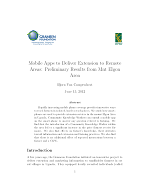CARD PPI Mini Case Study
 In 2009, the Grameen Foundation selected CARD Bank, a Philippine microfinance institution (MFI) with over 580,000 clients, to participate in its Microsavings Initiative. This case study describes how CARD Bank has used the PPI to identify opportunities for product cross-selling.
In 2009, the Grameen Foundation selected CARD Bank, a Philippine microfinance institution (MFI) with over 580,000 clients, to participate in its Microsavings Initiative. This case study describes how CARD Bank has used the PPI to identify opportunities for product cross-selling.


 This case study describes the role of Grameen Foundation in developing training programs for Oikocredit partner MFIs in the Philippines and Peru.
This case study describes the role of Grameen Foundation in developing training programs for Oikocredit partner MFIs in the Philippines and Peru. This case study describes how NWTF, an early adopter of the PPI, piloted and implemented the new poverty assessment tool. It outlines the experiences of NWTF management and staff as they made key decisions related to testing and data analysis.
This case study describes how NWTF, an early adopter of the PPI, piloted and implemented the new poverty assessment tool. It outlines the experiences of NWTF management and staff as they made key decisions related to testing and data analysis. This study finds that the introduction of a Community Knowledge Worker within the area led to a signicant increase in the price farmers receive for maize. It also finds effects on farmer's knowledge, their attitudes toward information and extension and farming practices.
This study finds that the introduction of a Community Knowledge Worker within the area led to a signicant increase in the price farmers receive for maize. It also finds effects on farmer's knowledge, their attitudes toward information and extension and farming practices. This document explains our MOTECH project in Ghana and highlights key lessons learned by the project team as the system was being designed, developed and implemented. Although MOTECH is viewed as a “technology project,” the majority of the lessons learned are around operational issues, cultural components and operating with partners to make the project successful.
This document explains our MOTECH project in Ghana and highlights key lessons learned by the project team as the system was being designed, developed and implemented. Although MOTECH is viewed as a “technology project,” the majority of the lessons learned are around operational issues, cultural components and operating with partners to make the project successful. Prevailing wisdom holds that the ultra-poor are too poor to save money. This study examines the savings behavior of ultra-poor women served by the Livelihood Pathways for the Poorest project, which is jointly implemented by Grameen Foundation and the Livelihood School (part of BASIX group of companies), in Gaya District, Bihar, India.
Prevailing wisdom holds that the ultra-poor are too poor to save money. This study examines the savings behavior of ultra-poor women served by the Livelihood Pathways for the Poorest project, which is jointly implemented by Grameen Foundation and the Livelihood School (part of BASIX group of companies), in Gaya District, Bihar, India. The mobile phone is gaining widespread popularity as a means to bridge the “last mile” – to bring information and financial services to people without ready access to them. To get a better picture of how to best deliver mobile services, we conducted a case study with our partner, Cashpor Microcredit, based in Varanasi, India.
The mobile phone is gaining widespread popularity as a means to bridge the “last mile” – to bring information and financial services to people without ready access to them. To get a better picture of how to best deliver mobile services, we conducted a case study with our partner, Cashpor Microcredit, based in Varanasi, India. Most economic development programs that aim to reach the poorest households have not been designed using a sustainable business approach. Instead, these programs have been developed as grants and charity-driven projects. While there is a role for grant-driven programs, organizations can also make sustainable business decisions to extend outreach to poorer populations in the medium to long term.
Most economic development programs that aim to reach the poorest households have not been designed using a sustainable business approach. Instead, these programs have been developed as grants and charity-driven projects. While there is a role for grant-driven programs, organizations can also make sustainable business decisions to extend outreach to poorer populations in the medium to long term. Grameen Foundation’s holistic approach to microsavings provides the framework and tools to develop and offer convenient, accessible, and secure poverty-focused savings programs while building sound financial, organizational, and operational practices that help transform microfinance institutions (MFIs) from credit-led to demand-driven institutions.
Grameen Foundation’s holistic approach to microsavings provides the framework and tools to develop and offer convenient, accessible, and secure poverty-focused savings programs while building sound financial, organizational, and operational practices that help transform microfinance institutions (MFIs) from credit-led to demand-driven institutions. Targeting and selecting groups for social development programs based on poverty levels can be a powerful first step in achieving greater impact. However, the complex nature of poverty often leads to processes that are accurate, but extremely customized, making it difficult to make comparisons across projects and geographies. This paper presents a methodology that aims to address both these issues.
Targeting and selecting groups for social development programs based on poverty levels can be a powerful first step in achieving greater impact. However, the complex nature of poverty often leads to processes that are accurate, but extremely customized, making it difficult to make comparisons across projects and geographies. This paper presents a methodology that aims to address both these issues.